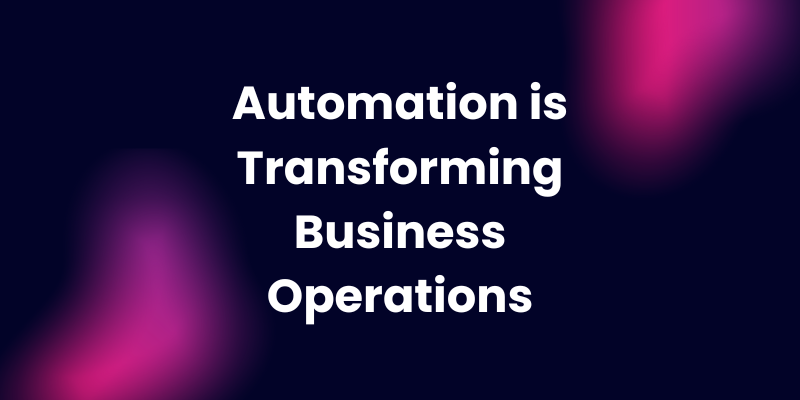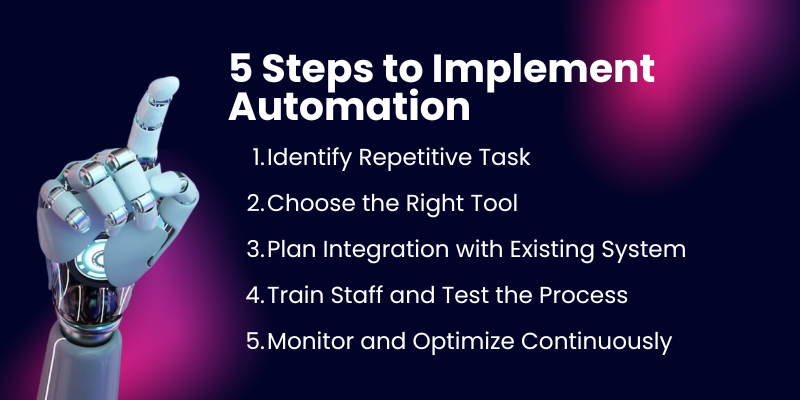In today’s fast-paced world, what is automation has become a critical question for businesses and individuals alike.
Automation refers to the use of technology to perform tasks with minimal human involvement. It has become essential for improving efficiency, consistency, and productivity across various industries.
From manufacturing to marketing, automation helps businesses optimize their processes, cut costs, and improve overall performance.
Whether it's robotic systems in factories, AI-driven tools for data analysis, or software that automates customer interactions, automation is revolutionizing how organizations operate.
For businesses, understanding what is automation is no longer a luxury but a necessity for staying competitive in the AI era.
In this blog, we will explore everything you need to know about automation and how it makes everyday life easier by saving time and reducing repetitive tasks.
What is Automation?
Automation refers to the use of technology and systems to perform tasks with minimal human intervention. It involves the creation and application of technologies that can handle repetitive, routine, and complex tasks more efficiently and accurately than humans.
These systems are designed to operate independently, eliminating the need for constant human monitoring and involvement. For instance, digital marketing strategies, such as using SEO ranking report software, can be automated to improve visibility without the need for constant manual effort.
Importance of Automation for Businesses and Individuals in the AI Era
In the AI era, automation has become an indispensable tool for businesses aiming to boost productivity, reduce operational costs, and enhance customer experiences. Automation empowers organizations to streamline their processes, minimize human error, and allocate resources more effectively. For example, companies are increasingly adopting SEO services to help boost organic traffic, which can be automated to keep websites ranking high with less human effort.
This integration also supports more advanced strategies, such as Google keyword ranking, helping businesses stay competitive. With the ability to quickly adapt to changes, businesses can scale operations, meet growing demand, and stay ahead in an increasingly competitive and fast-paced digital landscape. For individuals, automation in the AI era plays a crucial role in enhancing personal productivity by simplifying tasks and freeing up valuable time.
It offers a smarter way to manage daily life, whether it's automating household chores, managing schedules, or overseeing personal finances. Automation, powered by AI, helps individuals achieve a better work-life balance and make more efficient use of technology in their everyday routines.
How Automation is Transforming Business Operations?
Automation is fundamentally transforming how businesses operate, driving efficiency, scalability, and innovation across industries. What are five marketing strategies that retailers spend half of their annual budget on? Automation tools such as customer relationship management (CRM) systems and marketing automation software help retailers better manage these strategies and cut down on manual labor.

In manufacturing, companies like Amazon and Bausch + Lomb have integrated AI-powered robotics into their operations. Amazon employs over 750,000 robots in its warehouses, leading to a 25% reduction in order fulfillment costs and projected annual savings of $10 billion by 2030.
Retail giants such as Walmart are leveraging AI to optimize supply chain operations. In its high-tech grocery distribution centers, Walmart employs robotics and AI to process perishable goods more efficiently, reducing food waste and boosting profit margins.
The logistics sector in Japan is also experiencing a shift towards automation due to an aging workforce. At Amazon's Chiba fulfillment center near Tokyo, robots have outnumbered staff, enhancing capacity and efficiency.
These examples show how automation is not merely a technological advancement but a strategic imperative for businesses aiming to thrive in the modern economy.
3 Types of Automation Happening Around
Automation can be categorized into several types, each serving different industries and purposes, such as industrial, business, IT, marketing, and home automation. In marketing, for example, what is the digital marketing strategy that tracks users across the web? The implementation of tracking technologies like cookies and pixels is commonly automated to create personalized advertising and customer journeys.
1. IT Automation:Managing Servers, Software, and Infrastructur
IT automation focuses on automating repetitive IT tasks such as software updates, server provisioning, and infrastructure management.
It enables IT teams to manage systems more efficiently by reducing manual interventions and human errors. Common IT automation tools can monitor server performance, deploy software updates, and handle backups automatically.
IT automation increases system reliability, ensures uptime, and speeds up responses to system issues or failures, ultimately improving the IT department's productivity and performance.
2. Marketing Automation: Automating Campaigns and Customer Journeys
Marketing automation refers to the use of software to automate marketing tasks like email campaigns, social media posts, lead nurturing, and customer segmentation.
It allows businesses to deliver personalized content to customers based on their behaviors, interests, and engagement levels.
Marketing automation helps streamline customer journeys by automating follow-up emails, segmenting audiences, and tracking user interactions with minimal manual effort.
This type of automation not only saves time but also increases conversion rates, enhances customer experience, and improves ROI.
3. Home Automation: Smart Devices and IoT
Home automation involves the use of smart devices and the Internet of Things (IoT) to automate tasks within the home. It includes systems that control lighting, heating, security, appliances, and entertainment remotely.
With home automation, homeowners can set schedules, control devices via smartphones, and even use voice commands through virtual assistants like Amazon Alexa or Google Assistant.
These automations, combined with tech marketing agency strategies, has made smart home products highly popular.
This type of automation enhances convenience, energy efficiency, and security, offering homeowners a smarter, more connected way to manage their living spaces.
8 Key Automation Use Cases Across Different Industries
Understanding real-world automation examples is crucial as they showcase how automation saves time, reduces costs, and increases efficiency across different sectors.

In digital marketing, what is inbound marketing? It is a strategy where businesses use content marketing, social media, and SEO to attract customers, and automation helps streamline these processes. Businesses can automate tasks like email marketing, customer segmentation, and follow-ups, thereby enhancing customer relationships.
By automating routine and repetitive tasks, businesses can focus on innovation and more complex problem-solving, ultimately boosting productivity and growth.
1. Manufacturing and Industrial Use Cases
In manufacturing and industrial sectors, automation plays a pivotal role in improving efficiency and consistency. Robotics in production lines and assembly involves robots performing repetitive tasks such as assembly, welding, and packaging.
These robots operate with high precision and speed, reducing human error and increasing throughput, ensuring consistent quality in production processes.
Additionally, automation in SEO website builder tools helps manufacturers improve their digital presence, which is essential for driving online visibility.
Quality control using AI-powered sensors enhances this by detecting defects or quality issues during production. AI sensors help maintain product consistency, reducing the risk of faulty products reaching customers and minimizing the costs associated with product recalls.
Furthermore, predictive maintenance to prevent machine breakdowns utilizes automated monitoring systems that predict equipment failure before it happens.
By allowing repairs during planned downtime, it helps prevent unexpected breakdowns, ensuring continuous production and avoiding costly repairs.
2. Business Process Automation (BPA) Use Cases
Automated invoice processing and approvals streamlines workflows by automating the receipt, approval, and payment of invoices, ensuring accuracy and reducing financial delays.
In HR, automating recruitment and onboarding processes speeds up hiring and enhances the employee experience by automating tasks such as candidate screening and interviews.
Payroll and compliance management benefits from automation by handling payroll calculations, tax filings, and compliance checks, significantly reducing administrative overhead and minimizing errors.
For example, in the marketing world, businesses often explore what is B2B lead generation as part of their broader automation efforts. By automating lead collection and nurturing, they improve sales conversion rates and overall efficiency.
3. IT and Software Automation
In IT, server monitoring and self-healing systems automatically track server performance and resolve minor issues, reducing downtime and lessening the need for human intervention.
Automated backups and disaster recovery ensure critical data is continuously backed up, safeguarding against data loss and enabling quicker recovery during emergencies.
Additionally, continuous integration and deployment (CI/CD) automates the integration of code and software updates, enabling faster development cycles and more reliable software releases.
Automation also plays a role in improving web design and development processes by streamlining updates and modifications across multiple platforms.
4. Marketing Automation
Marketing automation is transforming how businesses engage with customers. Email marketing campaigns and audience segmentation enable businesses to send personalized, targeted messages to specific audiences, improving engagement and conversion rates.
Social media scheduling and analytics tools automate the posting of content, saving time, and providing valuable insights into performance metrics.
Customer journey personalization helps businesses deliver tailored content based on customer behaviors and preferences, enhancing the overall customer experience and fostering stronger relationships.
Ecommerce marketing automation further enhances this by streamlining the buying journey, ensuring a smooth customer experience from discovery to purchase.
Explore Our Digital Marketing Services!
5. Healthcare Automation
In healthcare, patient data management and electronic health records (EHR) systems automatically manage and update patient records, ensuring they remain accurate and accessible while meeting regulatory standards.
Appointment scheduling and reminders automate booking, rescheduling, and cancellation of appointments, reducing no-shows and improving patient management.
AI-driven diagnostics and treatment planning use algorithms to analyze medical data, assisting healthcare providers in diagnosing conditions and recommending personalized treatment options.
SEO services also help healthcare providers ensure that their services are visible online and easily accessible to potential patients.
6. Retail and E-Commerce
In retail and e-commerce, inventory tracking and restocking alerts automate inventory management, tracking product levels in real-time and alerting businesses when stock needs replenishing, ensuring a constant product supply.
Automated customer support via chatbots enables AI-powered interactions with customers, providing answers to queries, product recommendations, and issue resolution, which improves customer service efficiency.
Personalized product recommendations use customer behavior data to suggest products tailored to individual preferences, increasing the likelihood of conversions and enhancing the shopping experience.
Explore Our E-Commerce Marketing Services!
7. Home and Lifestyle Automation
At home, smart home devices for lighting and security automate tasks like controlling lights, security cameras, and door locks, enhancing convenience and security.
Voice assistants like Alexa or Google Home make managing smart devices easier through voice commands, helping users play music, set reminders, and access information hands-free.
Energy management and smart thermostats allow users to control home temperatures based on personal preferences, improving energy efficiency and comfort.
This integration mirrors how luxury brand marketing agency incorporates cutting-edge technology to engage customers, making their experience more personalized.
8. Financial Services and Banking
In financial services, fraud detection and risk management systems automatically monitor transactions for suspicious activities, reducing the risk of fraud.
Automated trading systems in financial markets use algorithms to make real-time trading decisions, optimizing investment strategies and opportunities.
AI-powered chatbots for customer service and support help bank customers check balances, transfer money, and resolve queries anytime, providing 24/7 assistance and improving customer service efficiency.
To further enhance digital experiences, companies often apply a noindex tag to avoid indexing certain web pages that are not intended for public viewing.
5 Steps to Implement Automation Successfully
Let's now explore what is automation and how we can implement it effectively. Successfully adopting automation in business processes requires thoughtful planning and a strategic approach. Choosing the right branding services can be one of the first steps, as a strong brand identity will enhance the automation process, especially when integrating various systems.

Here’s a step-by-step roadmap to adopt automation successfully:
1. Identify Repetitive Tasks
Start by identifying tasks that are repetitive, time-consuming, and prone to human error. These could include data entry, invoice processing, inventory management, or customer support. Prioritize tasks that consume a significant portion of your team’s time and can be easily automated without compromising quality.
2. Choose the Right Tools or Technologies
Select the appropriate tools or automation platforms that align with your business needs. Consider factors such as ease of integration, scalability, user-friendliness, and specific features relevant to your industry. There are numerous options available, from simple automation tools like Zapier to more advanced platforms like UiPath or Microsoft Power Automate
3. Plan Integration with Existing Systems
Before rolling out automation, plan how the chosen tools will integrate with your current systems. Ensure compatibility with software such as CRM, ERP, or financial management systems. A smooth integration process will help avoid data silos, streamline workflows, and prevent operational disruptions.
4. Train Staff and Test the Process
Train your staff on how to use the new automation tools effectively. It’s important to ensure that team members understand how to operate the system, monitor its performance, and intervene when necessary. Before fully implementing automation, conduct testing to iron out any issues, and ensure the system is functioning as expected.
5. Monitor and Optimize Continuously
Once the automation system is live, continuously monitor its performance to ensure it’s delivering the desired results. Look for areas that may need optimization, whether in task flow, speed, or user engagement. Automation is an ongoing process, and optimizing regularly will ensure that your business stays competitive and efficient.
7 Benefits of Automation
Automation is pivotal in modernizing industries and processes, offering many benefits that significantly impact efficiency, productivity, accuracy, and innovation. A strong understanding of automation concepts is essential to fully harness these advantages, as it enables businesses to implement smarter and more effective systems. Here’s a comprehensive look at the advantages of automation:
1. Higher Efficiency and Productivity
Automation streamlines workflows, cutting down on task completion time. It accelerates operations, enabling businesses to achieve greater results in shorter periods. When routine tasks are automated, efficiency soars, leading to boosted productivity. Consider how machine automation in logistics expedites order processing, allowing for quicker deliveries without sacrificing accuracy.
2. Enhanced Accuracy and Consistency
Automated systems execute tasks with exactness and reliability, reducing the errors commonly found in manual labor. This precision holds immense significance in sectors such as agriculture, where automated irrigation systems distribute water precisely, optimizing crop growth. Additionally, automated grading systems provide consistent and accurate assessments in education, eliminating human error in evaluations.
3. Cost Reduction
Although the upfront costs of adopting automation technology can be substantial, the enduring advantages surpass these expenses. Automation curtails labor costs by lessening the requirement for human involvement in day-to-day tasks. Furthermore, it maximizes energy efficiency, leading to gradual cost reductions in the long run. For instance, automated bricklaying significantly reduces labor costs while enhancing project efficiency in construction.
4. Improved Safety
Automation is crucial in mitigating the risks associated with hazardous or physically demanding tasks. In industries such as manufacturing and mining, robots and automated systems handle dangerous materials and operations, ensuring the safety of human workers. Additionally, automation in IT industry emphasizes cybersecurity automation and system monitoring to reduce human error and improve data safety. Autonomous systems in transportation also aim to enhance road safety by reducing human mistakes.
5. Easy Scalability and Flexibility
Automated systems swiftly respond to shifts in requirements and can efficiently expand operations. Take the hospitality industry, for example, where automation technologies like booking and resource management platforms dynamically adjust room availability and services based on demand fluctuations. This adaptability empowers businesses to manage surges in demand or changes in workload without heavy reliance on manual adjustments.
6. Enhanced Decision-Making Through Data Insights
Automation gathers and analyzes large volumes of data, providing valuable insights for informed decision-making. AI-powered analytics and machine learning algorithms process data patterns, enabling businesses to make data-driven decisions swiftly. This automated process allows industries such as finance to analyze market trends and customer behaviors more accurately for better investment decisions and personalized services.
7. Innovation and Competitive Advantage
Automation drives innovation by facilitating the creation of novel technologies and methodologies. Businesses that adopt automation gain a competitive advantage by becoming more adaptable, agile, and inventive. Consider the retail sector, where implementing automated inventory management systems allows companies to innovate in their supply chain strategies, adapting swiftly to changing market demands and customer preferences.
The Future of Automation
The future of automation, particularly in the AI era, is poised to revolutionize industries and daily life. Advancements in artificial intelligence are driving significant changes across various sectors.
Here are some key trends shaping the future of automation:
1. Agentic AI and Autonomous Systems
Agentic AI refers to autonomous systems capable of making decisions and taking actions to achieve specific goals.
These systems are increasingly being integrated into industries such as manufacturing, healthcare, and logistics to enhance efficiency and reduce human intervention.
For instance, AI-powered robots in factories are automating complex tasks, leading to faster production times and improved quality control.
2. Hyperautomation
Hyperautomation involves the use of advanced technologies like AI, machine learning, and robotic process automation (RPA) to automate complex business processes.
This approach enables organizations to streamline operations, reduce costs, and improve service delivery.
Companies are leveraging hyperautomation to automate end-to-end workflows, from data entry to customer service, resulting in enhanced productivity and customer satisfaction.
As an example, many businesses are adopting oil and gas marketing agency services to improve their digital strategies using hyperautomation.
3. AI-Powered Personalization
AI is enabling businesses to deliver highly personalized experiences to customers by analyzing vast amounts of data and predicting individual preferences.
This personalization extends to various touchpoints, including marketing campaigns, product recommendations, and customer support interactions.
For example, e-commerce platforms utilize AI algorithms to suggest products tailored to each user's browsing history and purchase behavior
4. AI-Driven Decision Making
Organizations are increasingly relying on AI to inform strategic decisions by analyzing data patterns and providing actionable insights.
AI tools assist in forecasting trends, optimizing supply chains, and identifying new business opportunities.
This data-driven approach enables companies to make informed decisions that enhance competitiveness and drive growth
5. Workforce Transformation
The integration of AI and automation is transforming the workforce by automating routine tasks and augmenting human capabilities.
While some jobs may be displaced, new roles are emerging that require skills in AI management, data analysis, and system integration.
Organizations are investing in reskilling and upskilling programs to prepare employees for these evolving roles
FAQs: What Is Automation?
What is Automation in Simple Words?
Automation means using automation technology to perform tasks automatically with minimal human effort, improving speed and accuracy.
What Are the 4 Types of Automation?
The main types include machine automation, automated systems, automated process, and automation technologies — each designed to simplify and optimize different kinds of work.
What is an Example of Automation?
An example of automation in IT industry is using software bots to manage data backups or monitor servers automatically.
What is Job Automation?
Job automation refers to applying understanding automation concepts to replace repetitive human tasks with intelligent systems that boost efficiency and consistency.
Conclusion
Now that you know what is automation, it's clear that this technology is transforming the way businesses and individuals operate. Automation not only streamlines processes but also drives efficiency, productivity, and innovation across various sectors. Whether it's enhancing manufacturing systems, optimizing marketing campaigns, or improving customer experiences, automation plays a vital role in enabling growth and scalability. As technology continues to evolve, integrating automation into daily operations will be key to maintaining competitiveness and staying ahead in the fast-paced digital landscape. At Centric, we help businesses harness the power of automation to drive sustainable growth and operational excellence.








